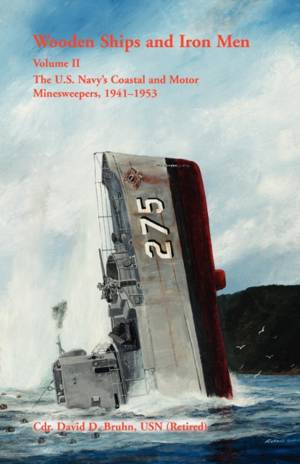
- Afhalen na 1 uur in een winkel met voorraad
- Gratis thuislevering in België vanaf € 30
- Ruim aanbod met 7 miljoen producten
- Afhalen na 1 uur in een winkel met voorraad
- Gratis thuislevering in België vanaf € 30
- Ruim aanbod met 7 miljoen producten
Zoeken
Wooden Ships and Iron Men
The U.S. Navy's Coastal and Motor Minesweepers, 1941-1953
David Bruhn
Paperback | Engels
€ 27,95
+ 55 punten
Uitvoering
Omschrijving
Possessing insufficient minesweepers to protect U.S. harbors and bays as the threat of war in Europe spread, in the winter of 1939-40 the Navy began purchasing fishing vessels and modifying them to combat mines. One of them, Condor (AMc-14), first sighted the Japanese Type-A midget submarine that destroyer Ward (DD-139) sank on December 7, 1941 with the first shots fired by American forces during World War II. She would be one of six coastal minesweepers to receive a battle star. From boat- and shipyards across America came the largest production run of any World War II warship, 561 scrappy little 136-foot wooden-hulled vessels characterized by Arnold Lott in Most Dangerous Sea as "belligerent-looking yachts wearing grey paint." Although their designers envisioned that they would operate primarily in the vicinity of yards or bases, the YMSs (too numerous to be given names) would see action in every theater of war, earning almost 700 battle stars, twenty-one Presidential Unit Citations, and fifteen Navy Unit Commendations. YMSs were present in the North African campaign, in Sicily, at Anzio, Salerno, and elsewhere in Italy, and swept ahead of invasion forces at Normandy and in Southern France. In the Pacific, they operated in the Marshall Islands, New Guinea, Solomons, Treasury Island, Gilbert Islands, New Britain, Admiralty Islands, Guam, Palau, Leyte, Luzon, Manila Bay, Iwo Jima, Southern Philippines, Okinawa, and Borneo. Following the war, they cleared mines from the East China Sea, Yangtze River approaches, and throughout Japanese waters, and their activities gave rise to the proud slogan of the mine force: "Where the Fleet Goes, We've Been." During the Korean War, a mere sixteen auxiliary motor minesweepers (former YMSs) performed the bulk of mine clearance, often while inside the range of enemy coastal artillery, necessary for larger naval vessels to close the coast to support operations ashore. Garnering collectively 124 battle stars, seven Presidential Unit Citations, and seven Navy Unit Commendations, the men aboard these ships were then, and remain to date, the most highly decorated crews of minesweepers in the history of the U.S. Navy.
Specificaties
Betrokkenen
- Auteur(s):
- Uitgeverij:
Inhoud
- Aantal bladzijden:
- 368
- Taal:
- Engels
Eigenschappen
- Productcode (EAN):
- 9780788449093
- Verschijningsdatum:
- 1/12/2012
- Uitvoering:
- Paperback
- Formaat:
- Trade paperback (VS)
- Afmetingen:
- 140 mm x 216 mm
- Gewicht:
- 426 g

Alleen bij Standaard Boekhandel
+ 55 punten op je klantenkaart van Standaard Boekhandel
Beoordelingen
We publiceren alleen reviews die voldoen aan de voorwaarden voor reviews. Bekijk onze voorwaarden voor reviews.








